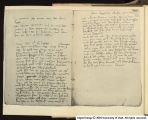| OCR Text |
Show OL APPLIANCE AN METHOD 12 mould. The next operation of the vatman was to pass the moul along the bridge to the second artisan, known as the "coucher, and proceed to form another sheet with a second mould, using th same deckle. The coucher placed the mould, with its thin mois sheet, against the inclined drainage-horn, which allowed the surplus water to drain back into the vat. When the wet sheet of pape had solidified upon the mould to the proper extent,-a stage determined by a distinctive lustre over its surfice-the couche turned the mould completely over and deposited the wet sheet o paper upon a piece of felting. The couching was done with quick, deft motion, rocking the mould from one long edge to th other, leaving the spongy shect, flat and unwrinkled, upon th rough woolen cloth. These processes we er and over the vatman and coucher working together, until a pdc nrm sheet of paper had been formed and couched, each sheet of wet pape separated from the next by a piece of felt somewhat larger than th size of the paper. The pile of six quires was termed a "post" an the next operation was to place the post in a press to expel th excess water e earliest form of Chinese papermaking the sheets wer dru.d directly upon the cloth moulds upon which they had bee rmed, so that couching, or removing thee p from the moul Whlle w et, was not required. Affer the introduction of the rigi mould, when dipping was used, it became the practice to couc cach sheet as it was made upo mat ed wool o but for long period the wet sheets of paper were couched one upon th other without anything between them. This method is in use a the present time in some parts of Asia At the introduction of papermaking into Europe felt of som kind was in all probability used as a mate rial for the couching o paper. Itis notl ot lkely that the old craftsmen employed woven woo cloth such as the makers of handmade paper use at present, but Digital Imag © 2004 University of Utah. Al rights reserved |



































































































































































































































































































































































































